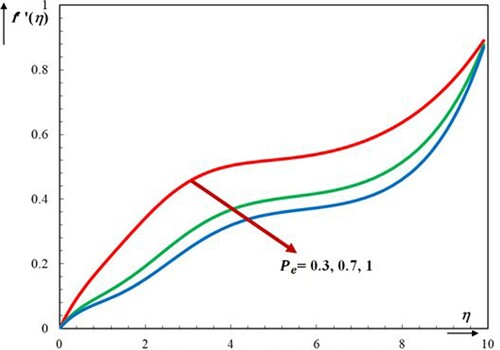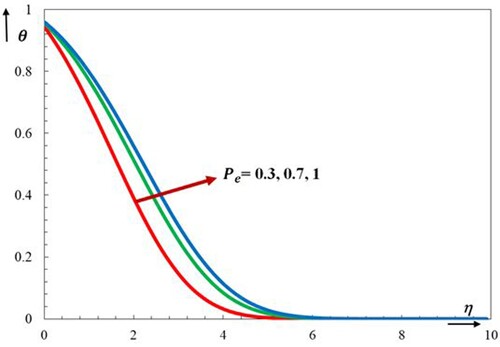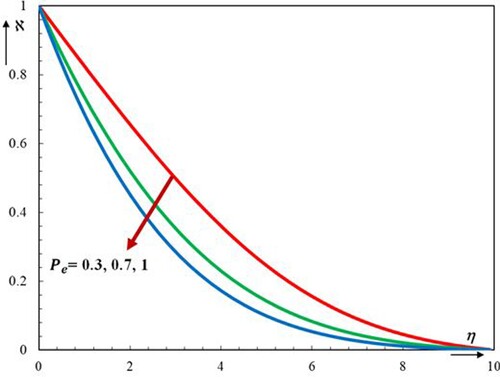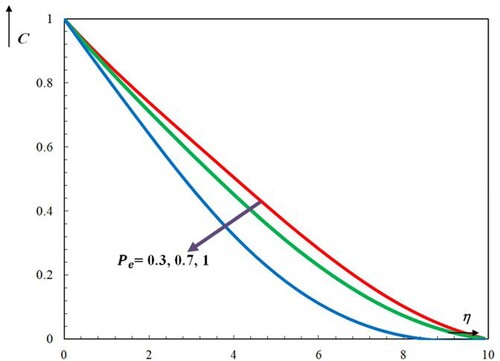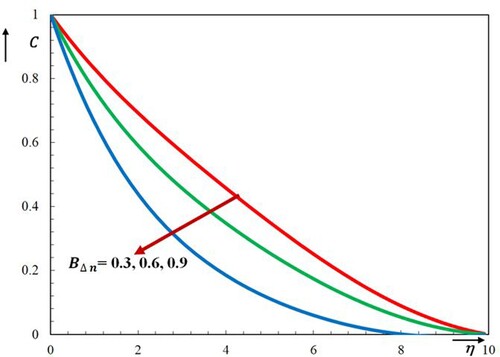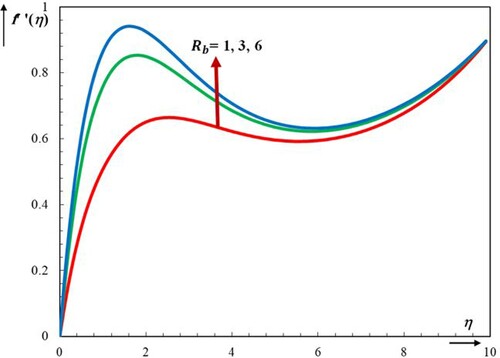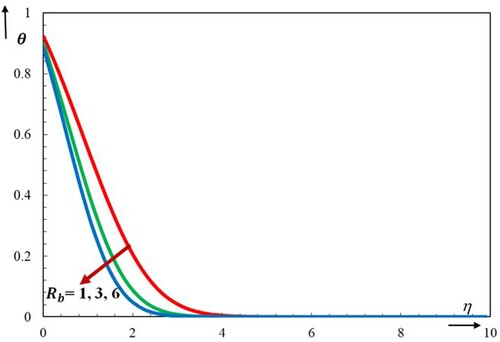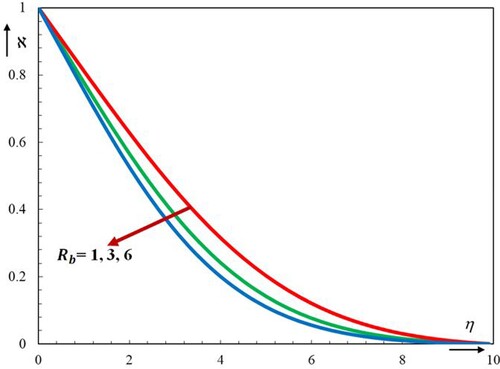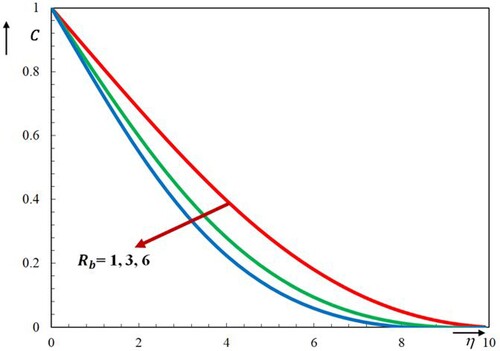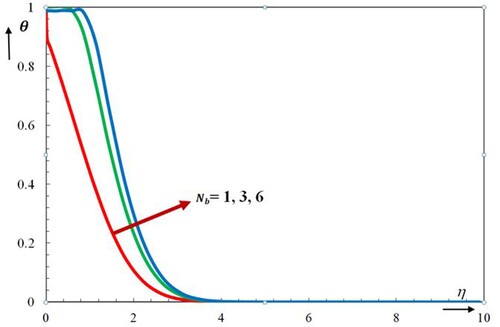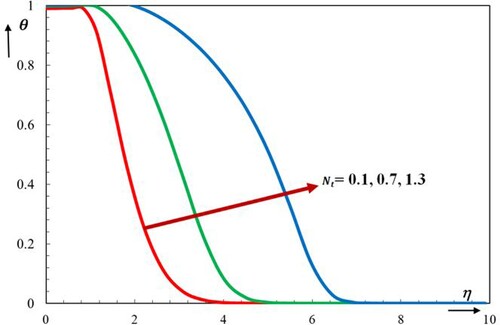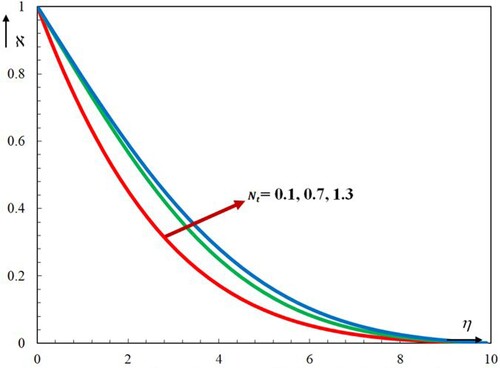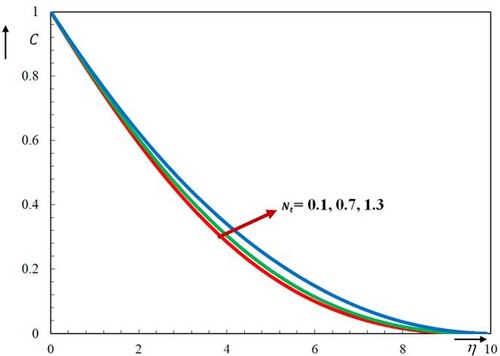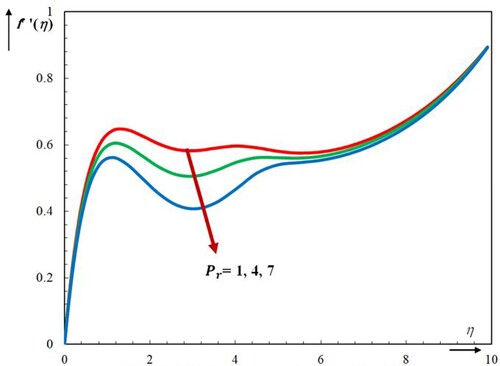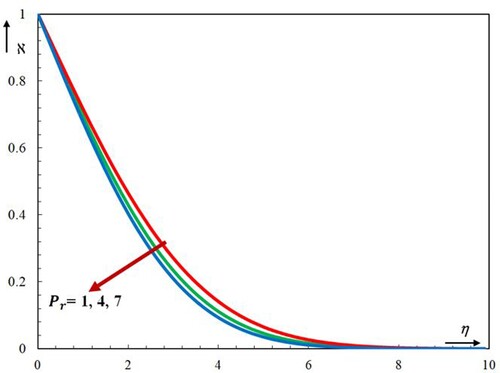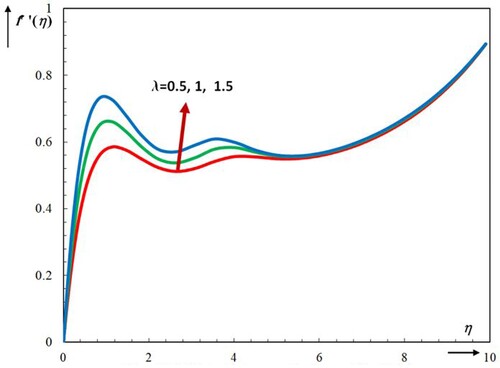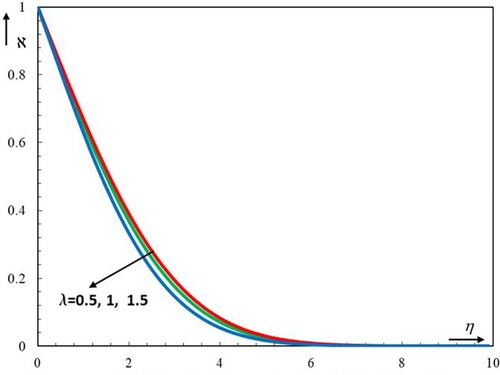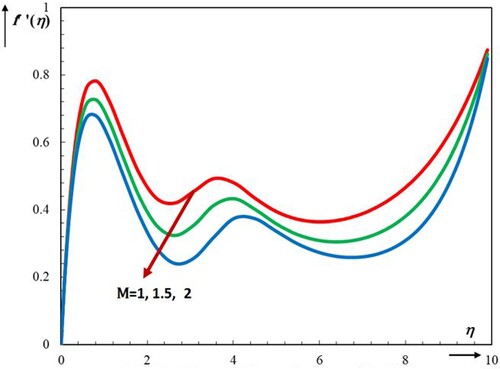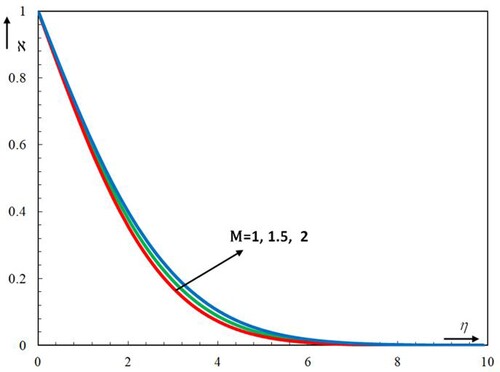 ?Mathematical formulae have been encoded as MathML and are displayed in this HTML version using MathJax in order to improve their display. Uncheck the box to turn MathJax off. This feature requires Javascript. Click on a formula to zoom.
?Mathematical formulae have been encoded as MathML and are displayed in this HTML version using MathJax in order to improve their display. Uncheck the box to turn MathJax off. This feature requires Javascript. Click on a formula to zoom.Abstract
A bioconvection MHD nanofluid flow which contains both nanoparticles and oxytactic bacteria is proposed. The role of oxytocic bacteria in cancer treatment is to hinder cancer development by actuating the immunity system. Oxygen-repellent bacteria as, a targeted drug delivery carriers towards infected cells, seem to be a promising tool in the fight against tumours. To depict the flow for this situation, a laminar steady incompressible nanofluid, containing oxytactic bacteria swimming heading a horizontal circular cylinder is considered. The thermal convective boundary conditions with variable physical parameters are taken. A numerical pseudospectral method is utilized. There is a considerable harmonization between the present outcome and some published papers. The current paper is supposed to give a serious understanding and deeper insight that can help develop drug-delivery applications in fluid encompassing hypoxic growth cells.
Nomenclature
| = | circular cylinder radius | |
| = | constant of chemotactic | |
| = | Biot number | |
| = | strength of magnetic field | |
| = | specific heat at constant pressure | |
| = | local skin-friction coefficient | |
| = | changeable Brownian diffusion coefficient | |
| = | constant Brownian diffusion coefficient | |
| = | changeable diffusivity of bacteria | |
| = | constant diffusivity of bacteria | |
| = | bacterial thermophoretic diffusion coefficient | |
| = | the diffusivity of oxygen | |
| = | velocity in dimensionless form | |
| = | gravitational acceleration | |
| = | Grashof number | |
| = | convective heat transfer coefficient | |
| = | dimensional positive constant | |
| = | temperature dependent viscous parameter | |
| = | dimensional positive constant | |
| = | temperature dependent thermal conductive parameter | |
| = | dimensional positive constant | |
| = | mass diffusivity parameter | |
| = | dimensional positive constant | |
| = | bacterial diffusivity parameter | |
| = | variable thermal conductivity of nanofluid | |
| = | constant thermal conductivity of nanofluid | |
| = | internal heat generation | |
| = | maximum cell swimming speed | |
| = | density of motile bacteria | |
| = | Brownian motion number | |
| = | buoyancy ratio parameter | |
| = | thermophoresis number | |
| = | Nusselt number | |
| = | density number | |
| = | bioconvection Péclet number | |
| = | Prandtl number | |
| = | wall heat flux | |
| = | bioconvection Rayleigh number | |
| = | Reynolds number | |
| = | dimensionless nanoparticle volume fraction | |
| = | Schmidt number | |
| = | temperature | |
| = | velocity components | |
| = | dimensionless velocity components | |
| = | velocity of the external flow | |
| = | free stream velocity | |
| = | Coordinate axes | |
| = | Dimensionless oxygen concentration |
Greek symbols
| = | thermal diffusivity | |
| = | coefficient of thermal expansion | |
| = | average volume of a microorganism | |
| = | motile parameter | |
| = | pseudo-similarity variable | |
| = | dimensionless temperature | |
| = | non-dimensional stream function | |
| = | mixed convection parameter | |
| = | variable temperature dependent viscosity | |
| = | constant temperature dependent viscosity | |
| = | kinematic viscosity | |
| = | dimensionless density of motile bacteria | |
| = | dimensionless coordinate | |
| = | ratio of effective heat capacity of the nanoparticle material to the fluid heat capacity | |
| = | wall skin friction in |
Subscripts/Superscripts
| = | condition at the wall | |
| = | condition at infinity | |
| = | differentiation with respect to |
1. Introduction
The medication conveyance framework dependent on nanomaterials still suffers from tormented by the issue of low designated conveyance productivity. Just about 1% of intravenously infused nanoparticles have the option to at last arrive at the growth site. Accordantly low designated conveyance effectiveness restricts the impact of cancer therapy. Lately, countless explorations on organic vectors have given novel plans to the designated conveyance of restorative specialists. Unprecedentedly Coley used bacteria to treat cancers in 1890s. In his examination, the cancer of a patient with osteosarcoma shrank fundamentally after the infusion of bacillus [Citation1]. The component of microorganisms intervened cancer treatment is to restrain cancer development by stimulating the immunity system. Microscopic organisms have been displayed to enlist incendiary cells into the growth microenvironment, like granulocytes and natural killer cells, the two of which are fundamental for repressing cancer reaction [Citation2]. Bacteria additionally showed qualities of straightforward hereditary designing, which can be modified to communicate hostile to growth sedates and accomplish designated treatment for cancers. Utilizing bacteria for malignant growth treatment is attainable and its capability to treat strong cancers has been known for quite a long time. In any case, the clinical utilization of this treatment never became standard on account of the antagonistic uncontrollable side effects [Citation3]. With an end goal to conquer these incidental effects, some constricted types of bacteria fit for treating malignancy have been lately recognized and considered. These types of microorganisms are viewed as safe for malignancy remedial application with practically zero incidental effects [Citation4]. While bacteria alone may not exhibit completely therapeutic potential, their alterations as anti-tumour specialists, antioncogenes, or immunogenic antigens, and their mix with other helpful cycles will work on their potential for cancer treatment [Citation5]. The field of utilizing bacteria as an anti-cancer specialist is still new; further examinations are basic to investigate the clinical meaning of microscopic organisms based cancer treatment. The discoveries introduced in this paper propose that this promising disease treatment should be improved and grown further. The microscopic organisms could effectively focus on the growth district, particularly advancing colonization in hypoxic and necrotic areas; Hypoxia is a typical quality of strong cancers [Citation6]. It is basically dictated by low degrees of oxygen coming about because of flawed vascular organizations providing most growths. Major pathogenetic instruments for the rise of hypoxia are (i) underlying and useful irregularities in the cancer microvasculature, (ii) an antagonistic diffusion geometry, and (iii) growth related and therapy-induced anaemia prompting a decreased oxygen transport limit of the blood [Citation7].
The mathematical model of oxytactic bacteria and bioconvection phenomenon play essential role in deepening the understanding widening the opportunities to improve drug-delivery with nanofluid in biological system [Citation8]. Various analysts were keen on such fields. The magneto-bioconvection flow of silver (Ag) magnesium oxide (MgO)- water hybrid nanoliquid in a permeable cavity considering the impact of gyrotactic microorganisms is discussed by Hussain et al. [Citation9]. The bloodstream of Carreau Yasuda liquid through a microvessel, swimming of gyrotactic microorganisms with nanoparticles is prescribed by Ibrahim et al. [Citation10]. The silver, magnesium oxide and gyrotactic microorganism-based hybrid nanofluid inside the cone shaped space among plate and cone is tended by Alrabaiah et al. [Citation11]. Thermo-bioconvection in a suspension of oxytactic bacteria within the sight of chemical reaction is proposed by Balla et al. [Citation12]. The investigation of bioconvection impacts on magnetic ferrofluid with nanoparticle suspension and motile microorganisms have been explained by Muhammad et al. [Citation13]. Gurunath et al. [Citation14] considered the bioconvection of magnetohydrodynamic Casson fluid with heat and mass transfer through a boundary layer flow containing gyrotactic microorganisms over a directly extending surface. The MHD flow of Burgers nanofluid arranged by an extending cylinder of thermal radiation, motile microorganisms, and chemical reactions are examined by Hassan et al. [Citation15]. The mathematical arrangement of steady and 2D flow of MHD Carreau nanofluid loaded up with motile microorganisms more than three distinct geometries has been investigated with Muntazir et al. [Citation16]. The uses of nano-suspension nanofluids in drug delivery, clinical treatment and cryopreservation are studied by Mojgan et al. [Citation17]. The heat and mass transfer rate and motile micro-organisms for convective second grade nanofluid flow is examined by Anum et al. [Citation18]. The blood flow through a microvessel including oxytactic microorganisms and nanoparticle is explained by Elogail et al. [Citation19]. The activity and association between the fundamental elements of the cancer cells including CD4+ T cells and the IFN-γ cytokines are demonstrated by Utaibi et al. [Citation20]. The mathematical investigation, which focuses around inflammatory syndrome set off by SARS-CoV2 contamination, is completed by Zhenhua et al. [Citation21]. The model which depends on the cooperation between cell populaces in therapeutic stress and cell populaces in neoplastic transformation are examined by Sohail et al. [Citation22]. Dynamical behaviour of the tuberculosis by applying both fractional model and fractional-mathematical model including Atangana–Baleanu derivatives is explored by Zain Ul Abadin et al. [Citation23,Citation24], toxoplasmosis disease in human and cat population in a non-integer mathematical model is proposed by Zain Ul Abadin et al. [Citation25]
In our paper, the flow has been considered as a laminar steady incompressible viscous boundary layer flow of a nanofluid with variable physical properties such as thermal conductivity, the fluid viscosity, nanoparticle concentration, and bacterial diffusivities. The nanofluid containing oxytactic bacteria is swimming in the direction of horizontal circular cylinder (resemble to cancerous cell surrounded by nanofluid as seen in Figure (a)). The bacteria which are member of the class of anaerobic and thrive without oxygen can be infused intravenously into people, so oxygen fixation devoured by microscopic organisms in the flow is completely depicted by oxygen conservation equation. The bacteria will fill just in the low-oxygen climate profound inside cancer; they are innocuous to the remainder of the body. The description of mathematical system can be very effective tool in understanding the drug delivery in the treatment which can be used experimentally by the cancerous tissue which is typically oxygen-starved. The thermal convective boundary conditions with variable physical parameters are taken. The governing nonlinear dimensionless PDEs are solved numerically utilizing implicit Chebyshev pseudospectral (ICPS) method.
Figure 1. (a) Tumour microenvironment to the breast cancer [Citation26], (b) Flow model containing oxytactic bacteria and nanoparticle with coordinate system, (c) Oxytactic bacteria injected intravenously into human.
![Figure 1. (a) Tumour microenvironment to the breast cancer [Citation26], (b) Flow model containing oxytactic bacteria and nanoparticle with coordinate system, (c) Oxytactic bacteria injected intravenously into human.](/cms/asset/e2801220-8e2b-4b2d-9304-dbd39c09f9b9/tusc_a_2106041_f0001_oc.jpg)
2. Formulation of the problem
The mathematical form of our investigation considers the infection cell as horizontal circular cylinder surrounded by a two dimensional boundary layer viscous laminar flow of an electrically conducting incompressible nanofluid with variable properties. Oxytactic bacteria swimming towards a horizontal circular cylinder with radius a subject to thermal convective boundary conditions is also considered. The fluid flow model and its application are shown in Figure (a–c).
The supposition is made that the temperature of the surface is while the temperature in the free stream is
such that
. The nanoparticle volume fraction,
, is accepted to be constant at the surface, and at the free stream is signified as
. The quantities
are supposed to be motile of bacteria at the wall and ambient value respectively. The fluid properties such as density
, the fluid electrical conductivity
and the specific heat at constant pressure
are assumed constant whereas both the thermal conductivity
, the fluid viscosity
, nanoparticle concentration, and bacterial diffusivities are modelled with the following mathematical functions [Citation27–30]:
(1)
(1) where,
, and
.
Under the above presumptions, the governing equations can be composed as follows [Citation30–32]:
Continuity equation
(2)
(2) Momentum equation
(3)
(3)
Energy equation
(4)
(4) Nanoparticles concentration
(5)
(5)
The bacterial conservation equation depends on the bioconvection’s model in a suspension of oxytactic bacteria created as:
(6)
(6) Consumption of oxygen by bacteria in the nanofluid [Citation33,Citation34]:
(7)
(7)
Here, are the velocity components along
-axes.
, and
indicate the nanofluid temperature, nanoparticle concentration, and density of motile bacteria, respectively.
, and
are volumetric thermal expansion coefficient of the nanofluid, gravitational acceleration, the density of the base fluid, and density of the nanoparticles, respectively.
denotes the ratio between the effective heat capacity of the nanoparticle material
to the fluid heat capacity
.
is the thermophoretic diffusion,
is the electrical conductivity,
is the greatest cell swimming speed,
is the chemotaxis constant, and
signifies the inside heat generation (
) or absorption (
). Moreover, the coefficient
represents the changeable temperature dependent viscosity and
represents the alterable thermal conductivity of nanofluids. Also,
is the variable diffusivity of Brownian motion, and
is the variable diffusivity of microorganisms’ coefficient.
and
are the temperature dependent viscous, thermal conductive, mass diffusivity, microorganism diffusivity parameters, respectively. Further, in Eq (6) the Heaviside step function,
is equal to unity. Also, in Eq (7) the last term
represents the consumption of oxygen by bacteria. It has been assumed that the nanoparticles don't the transfer of oxygen.
The relating boundary conditions can be composed as [Citation30,Citation35]:
(8)
(8)
According to [Citation35,Citation36] the external flow velocity for the boundary-layer equations can be composed as
, where
is the free stream velocity,
is the convective heat transfer coefficient and the subscripts. The associated non-dimensional parameters are defined as [Citation30,Citation37,Citation38]:
(9)
(9) By employing the overhead conversions in Equation (9) into the system (2)-(8) leads the following non-dimensional equations:
(10)
(10)
(11)
(11)
(12)
(12)
(13)
(13)
(14)
(14)
(15)
(15)
The dimensionless boundary conditions become:
(16)
(16) Here,
is the buoyancy ratio parameter.
and
are the thermophoresis and Brownian motion parameters, respectively.
and
are the mixed convection and magnetic field parameters, respectively.
and
are the production rate of oxygen and motile parameters, respectively.
,
,
,
,
,
,
, and
are the Grashof, Prandtl, Reynolds, Lewis, Schmidt, Eckert, bioconvection Rayleigh and bioconvection Péclet numbers, respectively.
,
,
, and
.
is the heat generation (
) or absorption (
) parameter.
In order to solve equations (10–15) with the boundary conditions (16), impose the hypothesis made by Merkin [Citation33], ,
,
,
, the dimensionless stream function
is characterized in the typical manner as
and
. Then the accompanying converted equations are:
(17)
(17)
(18)
(18)
(19)
(19)
(20)
(20)
(21)
(21)
According to:
(22)
(22) where, in the above system the differentiation
is with respect to
. It is seen close to the lower stagnation point of cylinder i.e. at
, the set of PDEs (17) - (21) reduce to the following ordinary differential equations:
(23)
(23)
(24)
(24)
(25)
(25)
(26)
(26)
(27)
(27)
with
(28)
(28)
The surface skin friction coefficient , Nusselt number
, the density number of the motile micro-organisms
, Sherwood number for nanoparticles
, and Sherwood number for oxygen concentration
are given by [Citation30,Citation33]:
(29)
(29)
(30)
(30)
(31)
(31)
(32)
(32)
(33)
(33)
3. Numerical procedure
In this section the implicit Chebyshev pseudospectral (ICPS) method is utilized. The code of the (ICPS) method is based on MATHEMATICA TM running on a PC. The governing system (17)-(21) is described by a set of PDEs in , which require the initial conditions at
. The system of PDE’s (17)-(22) has been solved numerically via the implicit Chebyshev pseudospectral (ICPS) procedure [Citation40,Citation41]. The highlighted numerical procedure has been explained in appendix A. Some numerical outcomes of the current investigation are compared with other previous published results and evident agreement is obtained as seen in Table .
Table 1. Comparison of for different values of
for
,
, and
.
4. Results and discussion
The current mathematical investigation gives a thorough system that help grasping disease development and testing biological speculations. By deciphering biological complexity and interpreting biological parts of cancer advancement into mathematical terms, the demonstrating system portrays cancer growth and related peculiarities as a complex set of cooperation with the arising result anticipated by mathematical investigation that characterizes the field of mathematical oncology, this field is described by two primary thoughts [Citation42,Citation43]:
Mathematics which is applied to improve the biomedical information on the illness,
Biology proposes new mathematical difficulties, which create improved mathematical apparatuses.
Drug delivery plans are key elements in the adequacy of cancer treatments. Mathematical displaying of population dynamics as well as treatment reactions can be utilized to distinguish better medication organization systems as well as to give unthinking bits of knowledge. To better use of this methodology, the cancer field should address the challenges of moving this sort of work into clinics [Citation44]. Computational oncology is a conventional term that includes any type of PC based displaying connecting with cancer therapy treatment. Mathematical modelling can be utilized to test the pharmacokinetics and pharmacodynamics connections of the accessible cancer treatment specialists to further develop therapy. Because of the always developing quantities of druggable molecular targets and conceivable medication mixes, getting an ideal poisonousness adequacy balance is an inexorably perplexing undertaking. Therefore, standard exact ways to deal with flowing drug dosing and planning for patients are presently of restricted utility; mathematical modelling can significantly propel this training through better justification of helpful techniques. The execution of mathematical modelling instrument is an arising pattern, yet remains to a great extent inadequate to meet clinical issues. Mathematical modelling is an appealing methodology that could assist with refining treatment modalities at all periods of innovative work, and in routine patient consideration [Citation45]. Mathematical oncology has presented critical logical bits of knowledge throughout the dynamics of cancer development and therapy reaction and is interestingly situated to assist ance a chart the multi-layered treatment reaction space [Citation46], mathematical model finds the peculiarity that lower antibody concentrations invigorate cancer development and higher concentrations hinder development [Citation47].
The majority of the systems that make up a living organism are available either in a steady state or in a way to deal with a consistent state. The blood comes basically to harmony with its environmental elements in the two lungs and tissues. The blood overall is not in equilibrium but in a steady state through which oxygen and carbon dioxide are ceaselessly flowing irreversibly in inverse bearings [Citation48]. In this manuscript, a mathematical model for a laminar steady incompressible viscous boundary layer circular cylinder for nanofluid contains oxytactic bacteria, with variable physical properties has been described and our present outcomes are compared with some existing results in medical research. In our steady mathematical description, the time frame is out of scope of our study, but role of oxytactic bacteria, nanoparticle, thermal properties and nanofluid parameters are proposed numerically and graphically on nanofluid velocity, nanofluid temperature, density of motile bacteria, and oxygen concentration as following:
Role of oxytactic bacteria parameters such as, bioconvection Péclet number
, biconvection motile parameter
, Production rate of oxygen
, and Biconvection Rayleigh number
, the numerical results can be summarized as;
Péclet number refers to the measurement of mass transport by advection to mass transport by either dispersion or diffusion, Figures , , depict that the nanofluid velocity
, motility of bacterial density
and oxygen concentration
decrease as Péclet number
increases, whereas Figure declares that the nanofluid temperature increases as Péclet number
increase; this result gives indication that the bacteria will grow only in the low-oxygen environment deep within a tumour as transport by advection and transport by diffusion increases, hence cancer treatment will very effective, this is the same results mentioned by Xiao et al. [Citation49],
Figure clears that the motility of bacterial density will increase as biconvection motile parameter
decreases. This result declares that the centralization of the capacity of bacteria to move autonomously utilizing metabolic energy isincreasing as the pattern shaping convective movements set up in suspensions of swimming bacteria diminishes, also when the bacteria entities are heavier towards the back, gyrotaxis turns them so they swim towards locales of generally quick down-flow, which improve the cancer treatment [Citation50].
Oxygen concentration distributions decrease as the consumption of oxygen by bacteria in the fluid
increases as proposed in Figure , and because the bacteria will fill just in the low-oxygen concentration climate profound inside a tumour, so the cancer therapy will be successful as mentioned by Rakotomalala [Citation51].
Figures proposed the influences of bioconvection Rayleigh number
versus the governing functions of our problem, Figure indicates that the nanofluid velocity raises as biconvectionRayleigh number increases, whereas the nanofluid temperature, density of motile bacteria, and oxygen concentration decrease as bioconvectionRayleigh number
increases. Then, at that point, the main thrusts of natural convection, and the property of a fluid that decides how heat is moved all through the fluid lead to increasing of nanofluid velocity and decreasing in oxygen concentration.
Nanoparticle parameters influence velocity temperature, nanoparticle concentration and bacterial density concentration: The raising of both Brownian motion number
and thermophoresis number
leads to increasing of nanofluid temperature, density of motile bacteria and oxygen concentration as described in the Figures . Our numerical investigation indicates that when we apply medical cancer treatment the force of a temperature gradient due to the mixtures of moving particles for different particle types must be small to decrease oxygen concentration [Citation52].
Impact of thermal properties and nanofluid parameters such as Prandtl number
, mixed convection parameter
and magnetic parameter
The nanofluid velocity and density of motile bacteria are increasing as Prandtl number
increases as shown in Figures ,. In applying medical treatment, the mathematical procedures predict that the ratio between thermal diffusivity and the momentum diffusivity is preferred to be small enough to ensure that the nanofluid velocity distributions increase. The medical treatment will be effective as long as there is elevation in nanofluid velocity curves as proposed by Mojgan et. al [Citation53].
The nanofluid velocity increases as mixed convection parameter
increases; while density of motile bacteria are decreasing as mixed convection parameter increases as shown in Figures ,. The cancer therapy by oxytactic bacteria will be more powerful by increasing proportion of the impact of the free convection in correlation with that of forced convection on the fluid flow.
The raising in magnetic parameter leads to decreasing in nanofluid flow distributions as proposed in Figure , whereas the density of motile bacteria are decreasing as magnetic parameter increases as shown in Figure .
Finally Table illustrates the effects of various physical parameters such as mixed convection parameter , Prandtl number
, buoyancy ratio parameter
, thermophoresis number
, Brownian motion number
, Schmidt number
, Lewis number
, heat generation parameter
, and production rate of oxygen
on surface skin friction coefficient
, Nusselt number
, the density number of the motile micro-organisms
, Sherwood number for nanoparticle
, and Sherwood number for oxygen concentration
, which are related to
,
,
,
, and
respectively. It’s clear that the influence of Schmidt number
on
,
, and
is not significant, with raising of Schmidt number, the value of
is decreasing while the value of
is increasing. With increasing of mixed convection parameter
, buoyancy ratio parameter
, Lewis number
, and production rate of oxygen
parameters the values of
,
,
,
, and
are increasing. The behaviour of
is decreasing as Prandtl number
increasing, whereas
,
,
, and
increase as Prandtl number
increase. With elevation of thermophoresis number
the values of,
,
,
, and
are increasing while the value of
is decreasing. It’s observed that with raising the values of Brownian motion number
the values of
,
,
,
, and
will be decreased. Heat generation parameter
causes decreasing in the values of
,
, and
. It is also has opposite effects on the values of both
and
Figure .
Table 2. Behaviour of ,
,
,
and
for different physical parameter.
5. Conclusions
A numerical model for a laminar steady incompressible viscous boundary layer circular cylinder for nanofluid with variable physical properties has been depicted. A scheme of the integration between experiments and mathematical models of antibody nanoconjugates (ANC) in tumour treatment is presented in Figure [Citation54]. The mathematical simulation of our paper gives a very important indication in medical treatment, these results can be highlighted through tables and graphs and are listed as follows:
Figure 23. Scheme of the integration between experiments and mathematical models [Citation54].
![Figure 23. Scheme of the integration between experiments and mathematical models [Citation54].](/cms/asset/04285837-eff7-4075-8576-07232c2c50d8/tusc_a_2106041_f0023_oc.jpg)
The cancer therapy is exceptionally successful when mass transport by advection to mass transport by either dispersion or diffusion is expanding.
The microscopic organisms’ substances are heavier towards the back, gyrotaxis turns them so they swim towards regions of speedy down-flow, which work on the cancer therapy.
The oxygen concentration appropriations decline as the utilization of oxygen by microscopic organisms in the fluid increments and as the bacteria will fill simply in the low-oxygen concentration environment significant inside a tumour, so the cancer treatment will beeffective.
The primary purposes of natural convection, and the property of a fluid that chooses how heat is moved all through the fluid prompts expanding of nanofluid velocity and diminishing in oxygen concentration, and this is exceptionally powerful sign for therapy for cancer treatments by applying oxytactic microscopic organisms.
The force of a temperature gradient attributed to combinations of portable particles, for various molecule types should be little to diminish oxygen concentration in applying clinical cancer therapy
The cancer treatment by oxytactic microscopic organisms will be amazing if the extent of the free convection in relationship with that of forced convection on the fluid flow will be expanded.
The values magnetic parameter should be sufficiently little to guarantee that the nanofluid velocity will be expanded, in effective cancer treatments.
Disclosure statement
No potential conflict of interest was reported by the author(s).
References
- Patra JK, Das G, Fraceto LF, et al. Nano based drug delivery systems: recent developments and future prospects. J Nanobiotechnol 2018;16(71):1–33. doi:10.1186/s12951-018-0392-8.
- Gun SY, Lee SWL, Sieow JL, et al. Targeting immune cells for cancer therapy. Redox Biol. 2019;25:101174, doi:10.1016/j.redox.2019.101174.
- Schmidt CK, Medina-Sánchez M, Edmondson RJ, et al. Engineering microrobots for targeted cancer therapies from a medical perspective. Nat Commun. 2020;11:1–18. doi:10.1038/s41467-020-19322-7.
- Song S, Vuai MS, Zhong M. The role of bacteria in cancer therapy – enemies in the past, but allies at present. Infect Agent Cancer. 2018;13:9, doi:10.1186/s13027-018-0180-y.
- Oladejo M, Paterson Y, Wood LM. Clinical experience and recent advances in the development of listeria-based tumor immunotherapies. Front Immunol. 2021;14:12, doi:10.3389/fimmu.2021.642316.
- Chen Y, Du M, Yu J, et al. Nanobiohybrids: a synergistic integration of bacteria and nanomaterials in cancer therapy. BIOI. 2020;1:25–36. doi:10.15212/bioi-2020-0008.
- Al Tameemi W, Dale TP, Al-Jumaily RM, et al. Hypoxia-modified cancer cell metabolism. Front Cell Dev Biol. 2019;29. doi:10.3389/fcell.2019.00004.
- Alimoradi H, Matikonda SS, Gamble AB, et al. Hypoxia responsive drug delivery systems in tumor therapy. Curr Pharm Desi. 2016;22(19):2808–2820. doi:10.2174/1381612822666160217130049.
- Hussain S, Aly A, Öztopd H. Magneto-bioconvection flow of hybrid nanofluid in the presence of oxytactic bacteria in a lid-driven cavity with a streamlined obstacle. Int Commun Heat Mass Transfer. 2022;134:106029, doi:10.1016/j.icheatmasstransfer.2022.106029.
- Ibrahim M, Asfour H. The effect of computational processing of temperature- and concentration-dependent parameters on non-Newtonian fluid MHD: applications of numerical methods. Heat Transfer. 2022;51:1, doi:10.1002/htj.22432.
- Alrabaiah H, Bilal M, Khan M, et al. Parametric estimation of gyrotactic microorganism hybrid nanofluid flow between the conical gap of spinning disk-cone apparatus. Sci Rep. 2022;12:59, doi:10.1038/s41598-021-03077-2.
- Ch B, Alluguvelli R, Naikoti K, et al. Effect of chemical reaction on bioconvective flow in oxytactic microorganisms suspended porous cavity. J. Appl Comp Mecha. 2020;6:653–664. doi:10.22055/JACM.2019.14811.
- Imran M, Farooq U, Muhammad T, et al. Bioconvection transport of Carreau nanofluid with magnetic dipole and nonlinear thermal radiation. Case Stud Therm Eng. 2021;26:101129, doi:10.1016/j.csite.2021.101129.
- Sankad G, Maharudrapppa I, Dhange M. Bioconvection in Casson fluid flow with gyrotactic microorganisms and heat transfer over a linear stretching sheet in presence of magnetic field. Adv Math Sci J. 2021;10:155–169. doi:10.37418/amsj.10.1.16.
- Waqas H, Manzoor U, Shah Z, et al. Magneto-Burgers nanofluid stratified flow with swimming motile microorganisms and dual variables conductivity configured by a stretching cylinder/plate. Math Probl Engi. 2021 doi:10.1155/2021/8817435.
- Muntazir R, Mushtaq M, Jabeen K. A numerical study of MHD Carreau nanofluid flow with gyrotactic microorganisms over a plate, wedge, and stagnation point. Math Prob Eng. 2021. doi:10.1155/2021/5520780.
- Sheikhpour M, Arabi M, Kasaeian A, et al. Role of nanofluids in drug delivery and biomedical technology: methods and applications. Nanotechnol, Sci Appl. 2020;13:47–59. doi:10.2147/NSA.S260374.
- Shafiq A, Gh R, Ch K, et al. Second grade bioconvective nanofluid flow with buoyancy effect and chemical reaction. Symmetry (Basel). 2020;12:621. doi:10.3390/sym12040621.
- Elogail M, Kh M. Modulated viscosity-dependent parameters for MHD blood flow in microvessels containing oxytactic microorganisms and nanoparticles. Symmetry (Basel). 2020;12. doi:10.3390/sym12122114.
- Kh A-U, Sohail A, Yu Z, et al. Dynamical analysis of the delayed immune response to cancer. Results Phys. 2021;26:104282, doi:10.1016/j.rinp.2021.104282.
- Yu Z, Ellahi R, Nutini A, et al. Modeling and simulations of CoViD-19 molecular mechanism induced by cytokines storm during SARS-CoV2 infection. J Mol Liq. 2021;327:114863, doi:10.1016/j.molliq.2020.114863.
- Sohail A, Arif R, Azim QUA, et al. Piecewise fractional order modeling of the breast cancer epidemiology after the Atezolizumab treatment. Fractals. 2022. doi:10.1142/S0218348X22401764.
- Zafar Z, Zaibb S, Hussain M, et al. Analysis and numerical simulation of tuberculosis model using different fractional derivatives. Chao Solit Frac. 2022;160:112202, doi:10.1016/j.chaos.2022.112202.
- Zafar Z, Younas S, Zaib S, et al. An efficient numerical simulation and mathematical modeling for the prevention of tuberculosis. Inter J Biom. 2022;15(04):2250015, doi:10.1142/S1793524522500152.
- Zafar Z, Tunç C, Ali N, et al. Dynamics of an arbitrary order model of Toxoplasmosis ailment in human and cat inhabitants. J Taibah Univ Sci. 2021;15(1):882–896. doi:10.1080/16583655.2021.1990603.
- Subia B, Dahiya U, Mishra S, et al. Breast tumor-on-chip models: from disease modeling to personalized drug screening. J Control Release. 2021;331:103–120. doi:10.1016/j.jconrel.2020.12.057.
- Amirsom N, Md U, Md B, et al. Computation of melting dissipative magnetohydrodynamic nanofluid bioconvection with second-order slip and variable thermophysical properties. Appl Sci. 2019;9:1–19. doi:10.3390/app9122493.
- Nima N, Ferdows M, Adesanya S, et al. Double diffusivity heat generation effects on bioconvection process embedded in a vertical porous surface with variable fluid properties. J Therm Anal Calorim. 2020;145:2571–2580. doi:10.1007/s10973-020-09822-5.
- Elgazery NS, Elelamy AF. Multiple solutions for non-Newtonian nanofluid flow over a stretching sheet with nonlinear thermal radiation: application in transdermal drug delivery. Pramana J Phys. 2020;94:68, doi:10.1007/s12043-020-1925-x.
- Rashad AM, Nabwey HA. Gyrotactic mixed bioconvection flow of a nanofluid past a circular cylinder with convective boundary condition. J Taiwan Instit Chem Eng. 2019;99:9–17. doi:10.1016/j.jtice.2019.02.035.
- Zokri SM, Arifin NS, Mohamed MK, et al. Mathematical model of mixed convection boundary layer flow over a horizontal circular cylinder filled in a Jeffrey fluid with viscous dissipation effect. Sains Malay. 2018;47:1607–1615. doi:10.17576/jsm-2018-4707-32.
- Basha HT, Sivaraj R, Prasad VR, et al. Entropy generation of tangent hyperbolic nanofluid flow over a circular cylinder in the presence of nonlinear Boussinesq approximation: a non similar solution. J Therm Anal Calorim. 2020;143:2273–2289. doi:10.1007/s10973-020-09981-5.
- Nima NI, Ferdows M, Bég OA, et al. Biomathematical model for gyrotactic free-forced bioconvection with oxygen diffusion in near-wall transport within a porous medium fuel cell. Int J Biom. 2020;13:2050026, doi:10.1142/S1793524520500266.
- Kuznetsov AV. Nanofluid bioconvection: interaction of microorganisms oxytactic upswimming, nanoparticle distribution, and heating/cooling from below. Theor Comput Fluid Dyn. 2012;26:291–310. doi:10.1007/s00162-011-0230-1.
- Mondal SK, Pal D. Computational analysis of bioconvective flow of nanofluid containing gyrotactic microorganisms over a nonlinear stretching sheet with variable viscosity using HAM. J Comput Des Eng. 2020;7:251–267. doi:10.1093/jcde/qwaa021.
- Nazar R, Amin N, Filip D, et al. The Brinkman model for the mixed convection boundary layer flow past a horizontal circular cylinder in a porous medium. Int J Heat Mass Transfer. 2003;46:3167–3178. doi:10.1016/S0017-9310(03)00122-4.
- Anwar I, Amina N, Pop I. Mixed convection boundary layer flow of a viscoelastic fluid over a horizontal circular cylinder. Int J Non-Linear Mech. 2008;43:814–821. doi:10.1016/j.ijnonlinmec.2008.04.008.
- Rashad AM, Chamkha AJ, Modather M. Mixed convection boundary-layer flow past a horizontal circular cylinder embedded in a porous medium filled with a nanofluid under convective boundary condition. Comput Fluids. 2013;86:380–388. doi:10.1016/j.compfluid.2013.07.030.
- Merkin JH. Mixed convection from a horizontal circular cylinder. Int J Heat Mass Transfer. 1977;20:73–77. doi:10.1016/0017-9310(77)90086-2.
- Elgazery NS. An implicit-Chebyshev pseudospectralmethod for the effect of radiation on power-law fluid past a vertical plate immersed in a porous medium. Commun Nonlinear Sci Num Simul. 2008;13:728–744. doi:10.1016/j.cnsns.2006.07.002.
- Elgazery NS. Effects of variable fluid properties on natural convection of MHD fluid from a heated vertical wavy surface. Meccanica. 2012;47:1229–1245. doi:10.1007/s11012-011-9507-0.
- Elbarbary EM, El-Sayed SM. Higher order pseudospectral differentiation matrices. Appl Num Math. 2005;55:425–438. doi:10.1016/j.apnum.2004.12.001.
- Chauviere A, Hatzikirou H, Lowengrub J, et al. Mathematical oncology: how are the mathematical and physical sciences contributing to the war on breast cancer? Curr Breast Cancer Rep. 2010;2:121–129. doi:10.1007/s12609-010-0020-6.
- Michor F, Beal K. Improving cancer treatment via mathematical modeling: surmounting the challenges is worth the effort. Cell. 2015;19:1059–1063. doi:10.1016/j.cell.2015.11.002.
- Barbolosi D, Ciccolini J, Lacarelle B, et al. Computational oncology — mathematical modelling of drug regimens for precision medicine. Nat Rev Clin Oncol. 2016;13:242–254. doi:10.1038/nrclinonc.2015.204.
- Brady R, Enderling H. Mathematical models of cancer: when to predict novel therapies, and when not to. Bull Math Biol. 2019;81:3722–3731. doi:10.1007/s11538-019-00640-x.
- Xiao Y, Shen J, Zou X. Mathematical modeling and dynamical analysis of anti-tumor drug dose-response. Math Biosci Eng. 2022;19:4120–4144. doi:10.3934/mbe.2022190.
- Ferretti G, Fagoni N, Taboni A, et al. A century of exercise physiology: key concepts on coupling respiratory oxygen flow to muscle energy demand during exercise. Eur J Appl Phys. 2022;122:1317–1365. doi:10.1007/s00421-022-04901-x.
- Duong M, Qin Y, You S, et al. Bacteria-cancer interactions: bacteria-based cancer therapy. Exp Mol Med. 2019;51:152. doi:10.1038/s12276-019-0297-0.
- Lee H, Dey D, Kim K, et al. Hypoxia-responsive nano-medicine to overcome tumor microenvironment-mediated resistance to chemo-photodynamic therapy. Mater Today Adv. 2022;14:100218, doi:10.1016/j.mtadv.2022.100218.
- Rakotomalala A, Escande A, Furlan A, et al. Hypoxia in solid tumors: how low oxygenation impacts the “Six Rs” of radiotherapy. Front Endocrinol. 2021. doi:10.3389/fendo.2021.742215.
- Pandey M, Choudhury H, Vijayagomaran P, et al. Recent update on bacteria as a delivery carrier in cancer therapy: from evil to allies. Pharm Res. 2022;6:1–20. doi:10.1007/s11095-022-03240-y.
- Sheikhpour M, Arabi M, Kasaeian A, et al. Role of nanofluids in drug delivery and biomedical technology: methods and applications. Nanotechnol Sci Appl. 2020;13:47–59. doi:10.2147/NSA.S260374.
- Université de Bordeaux Thèse présentée pour obtenir le diplôme HABILITATION A DIRIGER DES RECHERCHES Spécialité: Mathématiques appliquées par Sébastien Benzekry. 2017.
Appendix A
This appendix is describing the numerical approach, implicit Chebyshev pseudospectral (ICPS) procedure for solving the system (17)-(22) by the following steps:
Put
in the system of PDEs (17)-(22), to obtain the system of nonlinear ODEs (23-28) in
.
Solving the nonlinear ODEs (23)-(28) numerically via the Chebyshev pseudospectral (CPS) technique with Newton-Raphson iteration approach [Citation32] (FindRoot-MATHEMATICA Command).
Using the numerical outcomes from the ODEs (23)-(28) as initial values to the system of nonlinear PDEs (17)-(22).
Solving the system of nonlinear PDEs (17)-(22) numerically via the implicit-Chebyshev pseudospectral (ICPS) method, for describing the numerical approach see the flow chart in Figure .
The Chebyshev pseudospectral technique is applied in the -direction as well as the
derivatives are evaluated by the Crank-Nicolson method to obtain the next linear implicit-Chebyshev pseudospectral system, where the domain
is mapped into the computational one
as follows:
Consequently, the corresponding ICPS boundary conditions can be written as:
Here,
are the grid points where
, r = 0, 1, 2, . . . and
is the step sizes in
-direction as well as and
, for
. Also
is the nth pseudospectral differentiation matrix which is defined as [Citation49]:
and
Such that
and
for
and
for
.
The MATHEMATICATM software is used to solve the obtained algebraic system to calculate the values of , and
by marching in
-direction via (NSolve -MATHEMATICA Command) where
, and
are chosen, also the numerical values of some parameters, which have been used in our calculations is tabulated as follows:
Table

